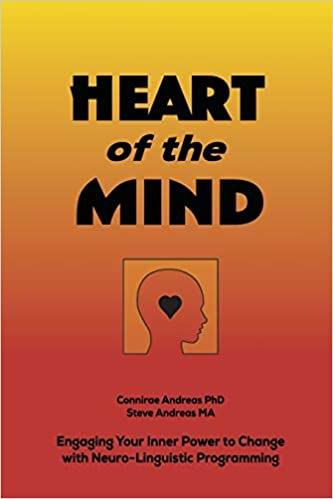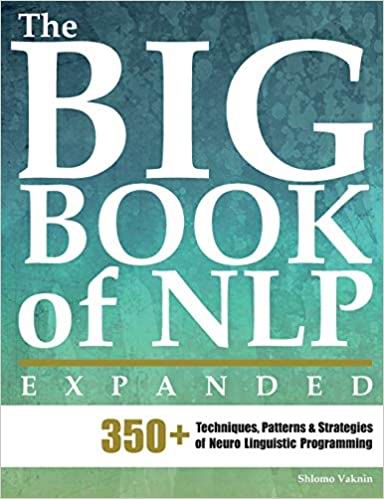Your unlimited powers: You can do more than you think!
What are our workshops and courses about?
How do I make my fear functional?
How do I feel the power of aging?
How do I increase my (self) trust?
Leave your 'JEANS' at home and take 'GUIDE' with you.
Create quality in your relations by compliments!
Using 'you' when I mean myself?
How do I release what I do not need?
The map is not the territory!
Cause-Consequence A self-test to determine to what extent you take the wheel of your life coach in your hands?
Dream day for advanced students in NLP
Create more happiness in your life
Eliminate negative memory


Books, literature about NLP:
Heart of the Mind
by Steve and Connirae Andreas
This well-written introduction to NLP covers many of lifeís challenges
and goals, using the authorsí multitude of successful techniques.
This comprehensive guide will serve as a platform to the beginning stages of NLP, diving deep into the inner workings of applying each technique in different situations.
Reading Purpose: Introduction to NLP for counselors, coaches and healing practitioners who want to see what itís like to apply various NLP methods with clients. Lots of client dialogue here.
Writing Style: Clinical, clear explanations of methods along detailed descriptions of client sessions.
The Big Book of NLP (Expanded)
by Shlomo Vaknin (Author), Marina Schwarts (Contributor)
The Big Book of NLP is a precisely written encyclopedia of NLP techniques and how they may be applied. With many techniques that are usually only talked about at expensive NLP seminars, this book contains a vast amount of information that cannot be found anywhere else.
Reading Purpose: Reference for NLP practitioners
Writing Style: No explanations or stories. This is just a list of techniques and their steps.
nlp booksNLP: The New Technology of Achievement
by Steve Andreas and Charles Faulkner
NLP can be utilized to solve many different problems, as well as achieve
goals. This book lays out a 21-day plan to help you achieve your goals,
and outlines the keys to unlimited success in your personal and professional
life, using NLP.
nlp booksFrogs Into Princes by Bandler and Grinder
Written when NLP was in the beginning stages of establishment, this book
captures the absolute essence of Neuro-Linguistic Programming as described
by the founding fathers, Richard Bandler and John Grinder. Though it contains
some of the more complicated techniques and processes, it is easily understandable
and should be read by anyone with an interest in the subject.
Reading purpose: To capture the atmosphere of early NLP seminars and the attitude with which they worked, mixed with a glimpse of the early methods.
Writing style: Seminar transcripts. This book is not written in a typical fashion, with one concept logically flowing after another Ė itís a snapshot of a live event.
nlp booksTrance-formations by Bandler and Grinder
The practice of hypnosis is filled with mysticism, and many openly criticize
it because they simply donít understand or have been fooled by a false
practitioner. This book breaks down the process of hypnosis, and Richard
Bandler and John Grinder, founders of Neuro-Linguistic Programming, explain
the techniques and methods used therein.
Reading purpose: To capture the atmosphere of early NLP seminars and the attitude with which they worked, mixed with a glimpse of the early methods around hypnosis, trance induction and utilization.
Writing style: Seminar transcripts. This book is not written in a typical fashion, with one concept logically flowing after another Ė itís a snapshot of a live event.
nlp booksReframing by Bandler and Grinder
Reframing your mind to adapt to a certain situation or scenario, and perceiving
it how you would like it to be perceived by your subconscious mind is
deeply explained in a six-step process, in this book by Richard Bandler
and John Grinder.
Reading purpose: To capture the atmosphere of early NLP seminars and the attitude with which they worked, mixed with a glimpse of the early methods around reframing.
Writing style: Seminar transcripts. This book is not written in a typical fashion, with one concept logically flowing after another Ė itís a snapshot of a live event.
nlp booksChange your Mind and Keep the Change by Steve and Connirae Andreas
Whether you are sticking to your personal convictions, motivating yourself
towards a difficult goal, or giving yourself support during a time of
need, this book will clearly lay out the road to self-support and help
you to find and keep the change that you need in your life.
Reading purpose: Introduction to NLP techniques
Writing style: Itís a live seminar transcript format here, but the editors did a great job of making the presentation clear from a readerís point of view.


